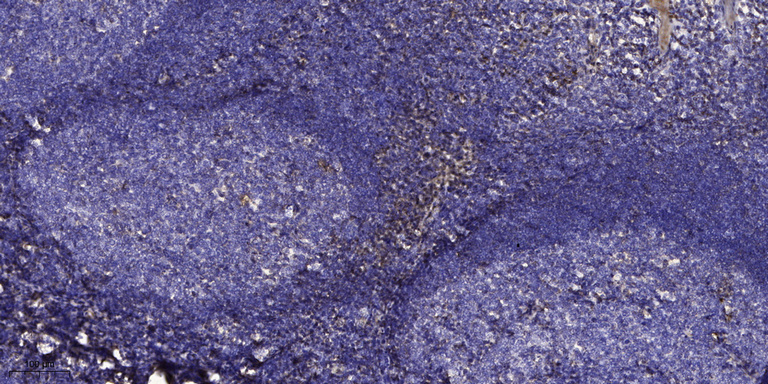Somatotropin Polyclonal Antibody
- Catalog No.:YT4366
- Applications:IHC;IF;ELISA
- Reactivity:Human;Rat;Mouse;
- Target:
- Somatotropin
- Fields:
- >>Cytokine-cytokine receptor interaction;>>Neuroactive ligand-receptor interaction;>>PI3K-Akt signaling pathway;>>JAK-STAT signaling pathway;>>Growth hormone synthesis, secretion and action
- Gene Name:
- GH1
- Protein Name:
- Somatotropin
- Human Gene Id:
- 2688
- Human Swiss Prot No:
- P01241
- Mouse Swiss Prot No:
- P06880
- Immunogen:
- Synthesized peptide derived from the Internal region of human Somatotropin.
- Specificity:
- Somatotropin Polyclonal Antibody detects endogenous levels of Somatotropin protein.
- Formulation:
- Liquid in PBS containing 50% glycerol, 0.5% BSA and 0.02% sodium azide.
- Source:
- Polyclonal, Rabbit,IgG
- Dilution:
- IHC 1:100 - 1:300. ELISA: 1:20000.. IF 1:50-200
- Purification:
- The antibody was affinity-purified from rabbit antiserum by affinity-chromatography using epitope-specific immunogen.
- Concentration:
- 1 mg/ml
- Storage Stability:
- -15°C to -25°C/1 year(Do not lower than -25°C)
- Other Name:
- GH1;Somatotropin;Growth hormone;GH;GH-N;Growth hormone 1;Pituitary growth hormone
- Molecular Weight(Da):
- 25kD
- Background:
- The protein encoded by this gene is a member of the somatotropin/prolactin family of hormones which play an important role in growth control. The gene, along with four other related genes, is located at the growth hormone locus on chromosome 17 where they are interspersed in the same transcriptional orientation; an arrangement which is thought to have evolved by a series of gene duplications. The five genes share a remarkably high degree of sequence identity. Alternative splicing generates additional isoforms of each of the five growth hormones, leading to further diversity and potential for specialization. This particular family member is expressed in the pituitary but not in placental tissue as is the case for the other four genes in the growth hormone locus. Mutations in or deletions of the gene lead to growth hormone deficiency and short stature. [provided by RefSeq, Jul 2008],
- Function:
- alternative products:Additional isoforms seem to exist,disease:Defects in GH1 are a cause of isolated growth hormone deficiency type IB (IGHD IB) [MIM:262400]; also known as pituitary dwarfism I. IGHD IB is an autosomal recessive deficiency of GH which causes short stature.,disease:Defects in GH1 are a cause of isolated growth hormone deficiency type II (IGHD II) [MIM:173100]. IGHD II is an autosomal dominant deficiency of GH which causes short stature.,disease:Defects in GH1 are the cause of Kowarski syndrome [MIM:262650]; also known as pituitary dwarfism VI.,disease:Defects in GH1 may be a cause of short stature [MIM:604271]. Short stature is defined by a subnormal rate of growth.,function:Plays an important role in growth control. Its major role in stimulating body growth is to stimulate the liver and other tissues to secrete IGF-1. It stimulates both the differentiation and prolifera
- Subcellular Location:
- Secreted.
- Expression:
- Pituitary,
- June 19-2018
- WESTERN IMMUNOBLOTTING PROTOCOL
- June 19-2018
- IMMUNOHISTOCHEMISTRY-PARAFFIN PROTOCOL
- June 19-2018
- IMMUNOFLUORESCENCE PROTOCOL
- September 08-2020
- FLOW-CYTOMEYRT-PROTOCOL
- May 20-2022
- Cell-Based ELISA│解您多样本WB检测之困扰
- July 13-2018
- CELL-BASED-ELISA-PROTOCOL-FOR-ACETYL-PROTEIN
- July 13-2018
- CELL-BASED-ELISA-PROTOCOL-FOR-PHOSPHO-PROTEIN
- July 13-2018
- Antibody-FAQs
- Products Images

- Immunohistochemical analysis of paraffin-embedded human tonsil. 1, Antibody was diluted at 1:200(4° overnight). 2, Tris-EDTA,pH9.0 was used for antigen retrieval. 3,Secondary antibody was diluted at 1:200(room temperature, 30min).


